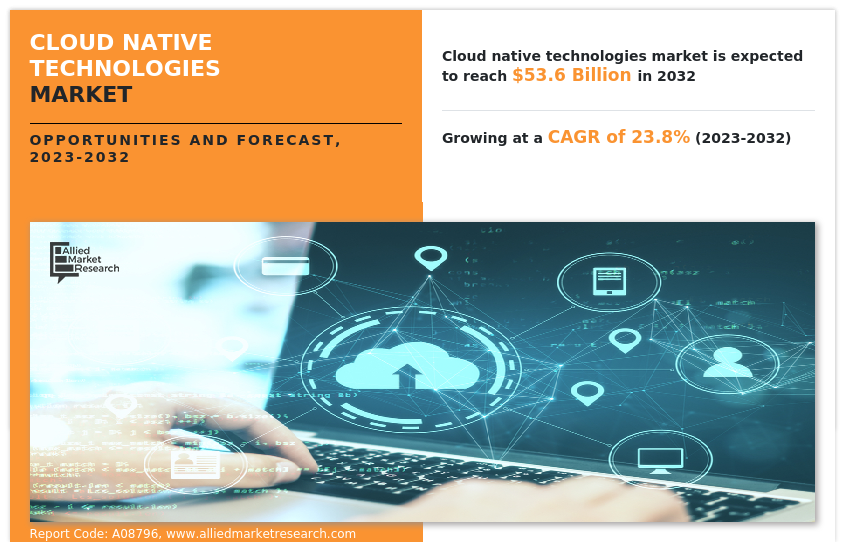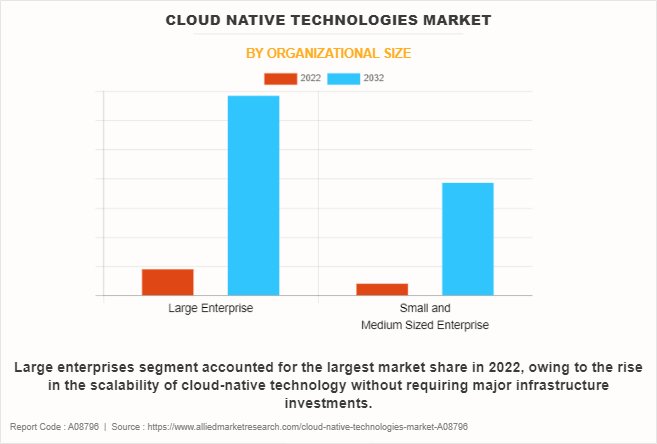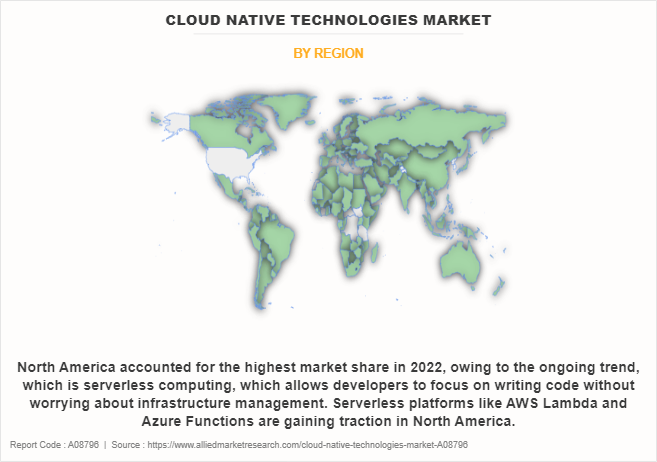Cloud Native Technologies Market Insights:
The global cloud native technologies market was valued at USD 6.5 billion in 2022, and is projected to reach USD 53.6 billion by 2032, growing at a CAGR of 23.8% from 2023 to 2032.
Cloud-native era is a software program method to building, deploying, and dealing with modern-day programs in cloud computing environments. Cloud-local applications are designed to be scalable, distinctly available, and easy to manage. They are constructed to exploit the size, elasticity, resiliency, and versatility the cloud presents. Cloud-native technology empower corporations to build and run scalable applications in public, private, and hybrid clouds. Features including packing containers, service meshes, microservices, immutable infrastructure, and declarative application programming interfaces (APIs) fine illustrate this method. These features enable loosely coupled structures which might be resilient, viable, and observable. They permit engineers to make high effect changes frequently and with minimum attempt.

Cloud-native technologies provide geared up-to-use equipment and services, along with bins (which includes Docker) and orchestration systems (including Kubernetes), which simplify deployment and control. Containers package the app and its dependencies, ensuring consistency throughout distinct environments. Meanwhile, orchestration gear automate and manage those containers, optimizing resource utilization and taking into account seamless scaling. This agility and scalability permit faster trying out, deployment, and updates, making it simpler for businesses to reply rapidly to marketplace demand for cloud nativeor consumer feedback substantially propelling the growth of the cloud local technologies market.
Moreover, the cost-effectiveness of cloud-native technologies assist associations in emerging nations in reducing their capital and operational expenses while still satisfying the developing need for data processing. As a result, the cloud native technologies market growth is expected to witness substantial growth, driven by the need for data center solutions that efficiently support the digital transformation and economic development of developing countries. This pattern benefits innovation suppliers as well as adds to connecting the advanced gap and working with financial advancement in these regions.
The report focuses on growth prospects, restraints, and trends of the cloud native technologies market analysis. The study provides Porter’s five forces analysis to understand the impact of various factors, such as the bargaining power of suppliers, competitive intensity of competitors, threat of new entrants, threat of substitutes, and bargaining power of buyers, on the cloud native technologies market Trends.
Segment Review:
The cloud native technologies market is segmented based on component, deployment mode, organization size, industry vertical, and region. Based on the component, the market is segmented into hardware, software, and services. By deployment mode, it is segmented into public cloud, private cloud, and hybrid cloud. Based on the organization size, the market is bifurcated into large enterprises and small and medium-sized enterprises. By industry vertical, it is bifurcated into BFSI, retail, manufacturing, healthcare, and others. Based on region, it is analyzed across North America, Europe, Asia-Pacific, and LAMEA.

By organizational size, the large enterprise segment held the highest market share in 2022, as large businesses handle growing workloads and accommodate growth owing to a rise in scalability without requiring major infrastructure investments. However, the small and medium-sized enterprises segment is projected to manifest the highest CAGR from 2023 to 2032, due to the benefit of technologies which include serverless computing and bins, which give better flexibility and decrease working expenses, due to cloud-native apps that assist pressure its adoption, further fueling growth.

Based on region, North America attained the highest market share in the cloud native technologies industry owing to the growing trend in serverless computing, which allows developers to focus on writing code without worrying about infrastructure management. Serverless platforms such as AWS Lambda and Azure Functions are gaining traction in North America, offering opportunities for developers and businesses to build and deploy applications more efficiently.
However, the market for cloud-native technologies is expected to develop at the fastest rate in the Asia-Pacific region. The adoption of cloud-native applications and microservices architectures is on the rise, as businesses seek greater agility and scalability. This trend is particularly evident in emerging markets such as India and Southeast Asia, where startups and enterprises are leveraging cloud-native solutions to innovate and compete in the global digital landscape.
Competition Analysis:
Some of the key players profiled in the report include Alibaba Group Holding Limited, Dell Technologies Inc., Dropbox, Google, Inc., Hewlett Packard Enterprise Development L.P., IBM Corporation, Microsoft Corporation, Oracle Corporation, Salesforce, and VMware, Inc. These players have adopted various strategies to increase their market penetration and strengthen their position in the cloud native technologies market.
Recent Partnerships in the Market:
In April 2022, Chronosphere, the leading cloud-native observability platform, partnered with Google Cloud. As go-to-market partners, Chronosphere and Google Cloud are working together to help customers quickly resolve incidents while controlling costs associated with cloud-native observability solutions. The multi-year agreement will support joint co-marketing and co-selling efforts through Google Cloud's Solution Connect program and Google Cloud Marketplace. As part of the partnership, the two companies will plan joint marketing campaigns, sales enablement, and mutual customer success initiatives.
In September 2023, Allcargo Group firm Gati partnered with Tech Mahindra to develop an application to boost productivity and unlock new business opportunities for the company.
In August 2023, CloudMile, a leading AI and cloud technology company based in Asia that focuses on digital transformation and growth for its corporate clients, has announced a strategic partnership with MongoDB, providing CloudMile’s corporate clients with MongoDB Atlas. Through this partnership, CloudMile's customers will have access to MongoDB Atlas a cloud-native developer data platform on Google Cloud to provide developers with the flexibility and scalability required to build enterprise-grade applications quickly and easily.
Recent Collaboration in the Market:
In February 2023, EPAM Systems, Inc., a leading digital transformation services and product engineering company, a strategic collaboration agreement with Amazon Web Services (AWS) to help enterprises solve complex business challenges, drive growth, and scale innovation through cutting-edge cloud solutions, services, and strategies. The agreement will focus on accelerating modernization, adopting cloud-native architecture, and leveraging artificial intelligence (AI) and advanced analytics to create customer value in key industries, including healthcare, life sciences, financial services, insurance, energy, and gaming.
In February 2023, StarHub will explore Google Cloud’s data management, AI and ML tools for its network operations and enhancing CX. New telecom innovations will provide CSPs with the ability to deploy true cloud-native networks in a hybrid cloud environment.
Recent Product Launches in the Market:
In November 2023, IBM announced a major evolution of its flagship IBM QRadar SIEM product: redesigned on a new cloud-native architecture, built specifically for hybrid cloud scale, speed, and flexibility. IBM also unveiled plans for delivering generative AI capabilities within its threat detection and response portfolio – leveraging Watsonx, the company's enterprise-ready data and AI platform.
In August 2023, Prosimo unveiled new innovations transforming how enterprises design, build, troubleshoot, and manage single and multi-cloud networking environments. The Cloud-Native Networking Suite aligns the cloud and network by bringing the focus on applications while providing a robust underlying networking architecture. Large enterprises, including F500 companies, have already adopted this suite to simplify cloud onboarding, reduce network delivery life cycles, shorten MTTR, and more efficiently manage cloud resources with cost-saving benefits.
In July 2022, Huawei Cloud launched a Cloud Native Core Banking solution to provide a stable cloud platform for offloading mainframes, building new core systems for traditional banks, and powering digital banks.
Key Benefits for Stakeholders:
- This report provides a quantitative analysis of the market segments, current trends, estimations, and dynamics of cloud native technologies market analysis from 2022 to 2032 to identify the prevailing cloud native technologies industry opportunities.
- The report provides a comprehensive analysis of the current market estimations through 2022-2032, which would enable the stakeholders to capitalize on prevailing market opportunities.
- In-depth analysis of cloud-native technologies market growth assists in determining the prevailing market opportunities.
- The report includes an analysis of the regional as well as cloud-native technologies market share, key players, market segments, application areas, and market growth strategies.
- Major countries are mapped according to their revenue contribution to cloud native technologies market size.
- Identify key players and their strategic moves in the cloud native technologies market forecast.
- Assess and rank the top factors that are expected to affect the growth of cloud-native technologies market outlook.
Cloud Native Technologies Market Report Highlights
| Aspects | Details |
| Market Size By 2032 | USD 53.6 billion |
| Growth Rate | CAGR of 23.8% |
| Forecast period | 2022 - 2032 |
| Report Pages | 378 |
| By Deployment Type |
|
| By Component Type |
|
| By Organizational Size |
|
| By Industry Vertical |
|
| By Region |
|
| Key Market Players | Cognizant, Infosys Limited, VMware, Inc., Alphabet Inc. (Google LLC), Amazon, Red Hat, Inc., IBM Corporation, SAP SE, Oracle Corporation, Microsoft Corporation |
Analyst Review
According to CXOs of the leading companies, due to the upward thrust in popularity of cloud computing and the want for scalable and agile software answers, the marketplace for cloud-local technologies is expanding notably. Applications which can be cloud-native are created to take full advantage of cloud infrastructure, allowing businesses to create, set up, and manipulate applications extra correctly.
The necessity for businesses to remain aggressive in a quickly changing virtual panorama is one of the primary elements driving the call for cloud-local packages. Modern groups anticipate quicker time-to-market, scalability, and resilience, and traditional monolithic apps no longer suit these wishes. Organizations design and deploy applications in a modular and scalable way, using cloud-native packages constructed the use of microservices structure, making it easy to react to converting business requirements. In the upcoming years, the demand for virtual transformation in addition to the growing usage of cloud computing is expected to drive a primary growth in the cloud local utility marketplace.
Platform-as-a-carrier (PaaS) and packing containers are the simplest two of the services that cloud infrastructure vendors offer, which make it simpler to design and install cloud local packages. However, to take advantage of cloud local apps, groups should cope with security worries and transition existing programmers to the cloud local architecture. Despite those obstacles, the cloud local utility marketplace is expected to be bigger as more organizations realize the benefits of creating and deploying apps natively within the cloud. For instance, in February 2023, Infosys partnered with ng-voice GmbH, a whole containerized and cloud-local IMS solution provider for the telecom marketplace. Under this partnership, both businesses labored collectively to supply exceptional managed services and cloud-native software program answers even as selling innovation and imparting tailored consumer studies to ng-voice clients.
Some of the key players profiled in the report include Alibaba Group Holding Limited, Dell Technologies Inc., Dropbox, Google, Inc., Hewlett Packard Enterprise Development L.P., IBM Corporation, Microsoft Corporation, Oracle Corporation, Salesforce, and VMware, Inc. These players have adopted various strategies to increase their market penetration and strengthen their position in the cloud native technologies market.
The upcoming trends of cloud native technologies market includes Kubernetes remains a cornerstone for managing containerized applications and continues to grow in adoption and functionality. In addition, increased interest in serverless architectures for their efficiency, scalability, and cost-effectiveness.
BFSI is the leading application of Cloud Native Technologies market
North America is the largest regional market for Cloud Native Technologies Market
The estimated industry size of Cloud Native Technologies is $ 53,587.42 million
The top companies to hold the market share in Cloud Native Technologies includes Alibaba Group Holding Limited, Dell Technologies Inc., Dropbox, Google, Inc., Hewlett Packard Enterprise Development L.P., IBM Corporation, Microsoft Corporation, Oracle Corporation, Salesforce, and VMware, Inc.
Loading Table Of Content...
Loading Research Methodology...



